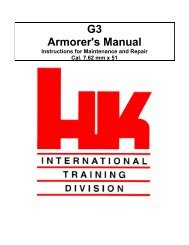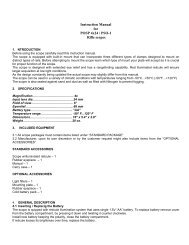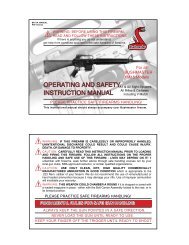FM 21-76 US ARMY SURVIVAL MANUAL - AR15.com
FM 21-76 US ARMY SURVIVAL MANUAL - AR15.com
FM 21-76 US ARMY SURVIVAL MANUAL - AR15.com
You also want an ePaper? Increase the reach of your titles
YUMPU automatically turns print PDFs into web optimized ePapers that Google loves.
<strong>FM</strong> <strong>21</strong>-<strong>76</strong> <strong>US</strong> <strong>ARMY</strong> <strong>SURVIVAL</strong> <strong>MANUAL</strong> Reprinted as permitted by U.S. Department of the Army<br />
• Place a warm, moist compress directly on the infected wound. Change the compress when it<br />
cools, keeping a warm compress on the wound for a total of 30 minutes. Apply the compresses<br />
three or four times daily.<br />
• Drain the wound. Open and gently probe the infected wound with a sterile instrument.<br />
• Dress and bandage the wound.<br />
• Drink a lot of water.<br />
Continue this treatment daily until all signs of infection have disappeared.<br />
If you do not have antibiotics and the wound has become severely infected, does not heal, and ordinary<br />
debridement is impossible, consider maggot therapy, despite its hazards:<br />
• Expose the wound to flies for one day and then cover it.<br />
• Check daily for maggots.<br />
• Once maggots develop, keep wound covered but check daily.<br />
• Remove all maggots when they have cleaned out all dead tissue and before they start on healthy<br />
tissue. Increased pain and bright red blood in the wound indicate that the maggots have reached<br />
healthy tissue.<br />
• Flush the wound repeatedly with sterile water or fresh urine to remove the maggots.<br />
• Check the wound every four hours for several days to ensure all maggots have been removed.<br />
• Bandage the wound and treat it as any other wound. It should heal normally.<br />
Skin Diseases and Ailments<br />
Although boils, fungal infections, and rashes rarely develop into a serious health problem, they cause<br />
discomfort and you should treat them.<br />
Boils<br />
Apply warm compresses to bring the boil to a head. Then open the boil using a sterile knife, wire, needle,<br />
or similar item. Thoroughly clean out the pus using soap and water. Cover the boil site, checking it<br />
periodically to ensure no further infection develops.<br />
Fungal Infections<br />
Keep the skin clean and dry, and expose the infected area to as much sunlight as possible. Do not<br />
scratch the affected area. During the Southeast Asian conflict, soldiers used antifungal powders, lye<br />
soap, chlorine bleach, alcohol, vinegar, concentrated salt water, and iodine to treat fungal infections with<br />
varying degrees of success. As with any "unorthodox" method of treatment, use it with caution.<br />
Rashes<br />
To treat a skin rash effectively, first determine what is causing it. This determination may be difficult even<br />
in the best of situations. Observe the following rules to treat rashes:<br />
• If it is moist, keep it dry.<br />
• If it is dry, keep it moist.<br />
• Do not scratch it.<br />
Use a compress of vinegar or tannic acid derived from tea or from boiling acorns or the bark of a<br />
hardwood tree to dry weeping rashes. Keep dry rashes moist by rubbing a small amount of rendered<br />
animal fat or grease on the affected area.<br />
Page 34 of 233








